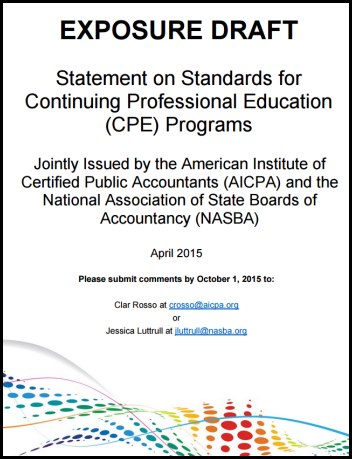Enforcement NewsletterAugust 2015On May 19, 2015, NASBA and the AICPA issued proposed revisions to the Statement on Standards for Continuing Professional Education (CPE) Programs (Standards). The approach to change to the Standards has been additive. The current, traditional instructional delivery methods remain. However, new instructional delivery methods – nano-learning and blended learning – have been included to allow for learning that is more personalized and available on demand (just in time). Nano-learningWhy should nano-learning be considered for CPE? The neuroscience supports smaller chunks of learning for maximum knowledge retention. Research has shown that our brains can pay full attention only 20 minutes at a time. When the brain is allowed to rest, the brain resets and allows itself to focus on new information. Space is needed between learning sessions for retention. Brains do not store memories – they grow memories. [Adapted from an article by Josh Davis, Maite J. Balda, and David Rock, published in the fifth edition of the Neuroleadership Journal (2014).] There is also a desire among CPAs for just-in-time learning to reinforce concepts as well as a desire to access this learning on demand and in a mobile manner. The proposed changes in the Standards for nano-learning define it as a separate instructional delivery method. The intent of the content of nano-learning is tutorial in nature. Nano-learning should teach by example or supply information to complete a certain task. Nano-learning programs must include an assessment of two questions that must be successfully passed at 100% to earn CPE credit. One-fifth credit (0.20 credit) is the maximum credit to be awarded a single nano-learning program. Blended learningAs the name suggests, blended learning combines a variety of instructional learning methods with providing the learner some element of control in its pace and consumption. Why consider it for CPE? The primary driver is personalization for the learner. When the learner controls to some degree the learning experience, it drives learner engagement. By offering a variety of learning methods, blended learning offers flexibility to cater to the varying needs and learning preferences of the participants. The proposed changes in the Standards for blended learning define it as a separate instructional delivery method. All program components must relate to the defined learning objectives of the program. CPE program sponsors must provide clear information that summarizes the components of the program and what must be completed or achieved during each component in order to qualify for CPE credits. CPE credit offered for blended learning equals the sum of the CPE credit for the completed components of the program. Comment PeriodThe exposure draft is available for download by clicking the graphic above and or on aicpa.org. We encourage you to include the review and discussion of the proposed changes to the Standards to your next Board meeting agenda. Please provide comment on the exposure draft by October 1, 2015. |
Full Newsletter |


